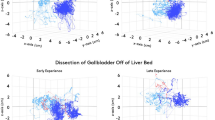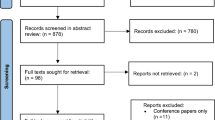Abstract
Objective
The objective of the study was to assess the validity of the NASA-TLX score in rating the workload of pediatric robotic operations.
Methods
The workload of 230 pediatric gastrointestinal and thoracic robotic operations was rated using the NASA-TLX score. The difference between the high workload group and the low workload group in each subscale of the NASA-TLX score was analyzed. The correlation of each subscale with the total workload score in the high workload group and low workload group was also analyzed. A logistic regression analysis was subsequently conducted to assess the effects of different factors (sex, age, weight, procedure duration, procedure specialties, combined malformation and blood loss) on the workload.
Results
The average NASA-TLX score was 56.5 ± 5.1 for the total group, 56.9 ± 5.0 for the gastrointestinal group and 54.6 ± 4.8 for the thoracic group, p = 0.007. The score of the high workload group was 62.7 ± 3.2, while it was 50.6 ± 2.7 for the low workload group (p < 0.001). The score on each subscale was also significantly different between the high and low workload groups. In the high workload group, a stronger correlation was observed between the total score and TD and Fr and a lower correlation with MD and Pe. In the low workload group, all six subscales showed a moderate correlation with the total score. A multivariate logistic regression analysis revealed that the procedure duration was an independent influencing factor for a higher workload score.
Conclusions
NASA-TLX is a valid tool to rate the surgeon’s workload in pediatric robotic surgery. A longer operative time contributes to a higher workload.




Similar content being viewed by others
References
Meininger DD, Byhahn C, Heller K, Gutt CN, Westphal K (2001) Totally endoscopic nissen fundoplication with a robot system in a child. Surg Endosc 15:1359–1361
Chang X, Cao G, Pu J, Li S, Zhang X, Tang ST (2021) Robot-assisted anorectal pull-through for anorectal malformations with rectourethral and rectovesical fistula: feasibility and short-term outcome. Surg Endosc 36:1910–1915
Cundy TP, Shetty K, Clark J, Chang TP, Sriskandarajah K, Gattas NE, Najmaldin A, Yang GZ, Darzi A (2013) The first decade of robotic surgery in children. J Pediatr Surg 48:858–865
Najarian S, Fallahnezhad M, Afshari E (2011) Advances in medical robotic systems with specific applications in surgery–a review. J Med Eng Technol 35:19–33
Gofrit ON, Mikahail AA, Zorn KC, Zagaja GP, Steinberg GD (2008) Surgeons’ perceptions and injuries during and after urologic laparoscopic surgery. Urology 71:404–407
Park A, Lee G, Seagull FJ, Meenaghan N, Dexter D (2010) Patients benefit while surgeons suffer: an impending epidemic. J Am Coll Surg 210:306–313
Butler KA, Kapetanakis VE, Smith BE, Sanjak M, Verheijde JL, Chang YH, Magtibay PM, Magrina JF (2013) Surgeon fatigue and postural stability: is robotic better than laparoscopic surgery? J Laparoendosc Adv Surg Tech A 23:343–346
Di Stasi LL, Diaz-Piedra C, Rieiro H, Sánchez Carrión JM, Martin Berrido M, Olivares G, Catena A (2016) Gaze entropy reflects surgical task load. Surg Endosc 30:5034–5043
Nakayashiki A, Kawaguchi T, Nakagawa A, Mochizuki F, Furukawa H, Nagai A, Suematsu T, Tominaga T (2019) Reducing surgeon’s physical stress in minimally invasive neurosurgery. J Neurol Surg A Cent Eur Neurosurg 80:333–340
Van’t Hullenaar CD, Ruurda JP, Broeders IA (2009) Ergonomics, user comfort, and performance in standard and robot-assisted laparoscopic surgery. Surg Endosc 23:1365–1371
Hart SG, Staveland LE (1988) Development of NASA-TLX (task load index): results of empirical and theoretical research. Adv Psychol 52:139–183
Tubbs-Cooley HL, Mara CA, Carle AC, Mark BA, Pickler RH (2019) Association of nurse workload with missed nursing care in the neonatal intensive care unit. JAMA Pediatr 173:44–51
Lund S, Yan M, D’Angelo J, Wang T, Hallbeck MS, Heller S, Zielinski M (2021) NASA-TLX assessment of workload in resident physicians and faculty surgeons covering trauma, surgical intensive care unit, and emergency general surgery services. Am J Surg 222:1158–1162
Stefanidis D, Wang F, Korndorffer JR Jr, Dunne JB, Scott DJ (2010) Robotic assistance improves intracorporeal suturing performance and safety in the operating room while decreasing operator workload. Surg Endosc 24:377–382
Lee GI, Lee MR, Clanton T, Sutton E, Park AE, Marohn MR (2014) Comparative assessment of physical and cognitive ergonomics associated with robotic and traditional laparoscopic surgeries. Surg Endosc 28:456–465
Meehan JJ (2009) Robotic surgery in small children: is there room for this? J Laparoendosc Adv Surg Tech A 19:707–712
Liu Y, Gao Q, Wu M (2022) Development of ants. Ergonomics 24:1–49
Li KW, Lu Y, Li N (2022) Subjective and objective assessments of mental workload for UAV operations. Work 72:291–301
Cao A, Chintamani KK, Pandya AK, Ellis RD (2009) NASA TLX: software for assessing subjective mental workload. Behav Res Methods 41:113–117
Lau E, Alkhamesi NA, Schlachta CM (2020) Impact of robotic assistance on mental workload and cognitive performance of surgical trainees performing a complex minimally invasive suturing task. Surg Endosc 34:2551–2559
Tubbs-Cooley HL, Mara CA, Carle AC, Gurses AP (2018) The NASA task load index as a measure of overall workload among neonatal, paediatric and adult intensive care nurses. Intensive Crit Care Nurs 46:64–69
Wilson MR, Poolton JM, Malhotra N, Ngo K, Bright E, Masters RS (2011) Development and validation of a surgical workload measure: the surgery task load index (SURG-TLX). World J Surg 35:1961–1969
Ma J, Lowndes B, Chrouser K, Hallbeck S, Mccrory B (2021) Developing a subjective instrument for laparoscopic surgical workload in a high fidelity simulator using the nasa-tlx and surg-tlx. IISE Transac Healthc Syst Eng 11:161–169
Lowndes BR, Forsyth KL, Blocker RC, Dean PG, Truty MJ, Heller SF, Blackmon S, Hallbeck MS, Nelson H (2018) NASA-TLX assessment of surgeon workload variation across specialties. Ann Surg 271:686–692
Mouraviev V, Klein M, Schommer E, Thiel DD, Samavedi S, Kumar A, Leveillee RJ, Thomas R, Pow-Sang JM, Su LM, Mui E, Smith R, Patel V (2016) Urology residents experience comparable workload profiles when performing live porcine nephrectomies and robotic surgery virtual reality training modules. J Robot Surg 10:49–56
Prabhu AS, Carbonell A, Hope W, Warren J, Higgins R, Jacob B, Blatnik J, Haskins I, Alkhatib H, Tastaldi L, Fafaj A, Tu C, Rosen MJ (2020) Robotic inguinal vs transabdominal laparoscopic inguinal hernia repair: the rival randomized clinical trial. JAMA Surg 155:380–387
Ruiz-Rabelo JF, Navarro-Rodriguez E, Di-Stasi LL, Diaz-Jimenez N, Cabrera-Bermon J, Diaz-Iglesias C, Gomez-Alvarez M, Briceño-Delgado J (2015) Validation of the NASA-TLX score in ongoing assessment of mental workload during a laparoscopic learning curve in bariatric surgery. Obes Surg 25:2451–2456
Law KE, Lowndes BR, Kelley SR, Blocker RC, Larson DW, Hallbeck MS, Nelson H (2020) Surgeon workload in colorectal surgery: perceived drivers of procedural difficulty. J Surg Res 245:57–63
Chi SQ, Cao GQ, Li S, Guo JL, Zhang X, Zhou Y, Tang ST (2020) Outcomes in robotic versus laparoscopic-assisted choledochal cyst excision and hepaticojejunostomy in children. Surg Endosc 35:5009–5014
Molinaro F, Angotti R, Bindi E, Pellegrino C, Fusi G, Luzzi L, Tosi N, Messina M, Mattioli G (2019) Low weight child: can it be considered a limit of robotic surgery? Experience of two centers. J Laparoendosc Adv Surg Tech A 29:698–702
Author information
Authors and Affiliations
Corresponding authors
Ethics declarations
Disclosures
Shuai Li, Yuan Liu, Kang Li, Guoqing Cao, Shiwang Li, Yong zhong Mao, Yong Wang, Jianjun Feng and Shao-tao Tang have no conflicts of interest or financial ties to disclose.
Additional information
Publisher's Note
Springer Nature remains neutral with regard to jurisdictional claims in published maps and institutional affiliations.
Rights and permissions
Springer Nature or its licensor (e.g. a society or other partner) holds exclusive rights to this article under a publishing agreement with the author(s) or other rightsholder(s); author self-archiving of the accepted manuscript version of this article is solely governed by the terms of such publishing agreement and applicable law.
About this article
Cite this article
Li, S., Liu, Y., Li, K. et al. Validation and effect of the NASA-TLX score on the assessment of the workload of pediatric robotic operations. Surg Endosc 37, 5077–5085 (2023). https://doi.org/10.1007/s00464-023-09959-y
Received:
Accepted:
Published:
Issue Date:
DOI: https://doi.org/10.1007/s00464-023-09959-y




